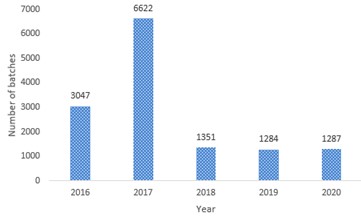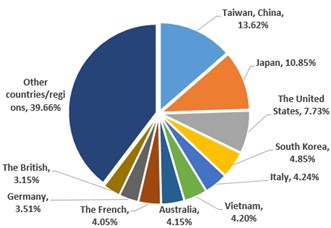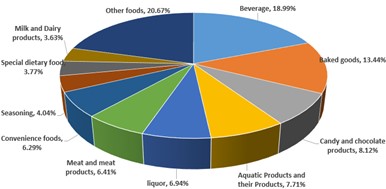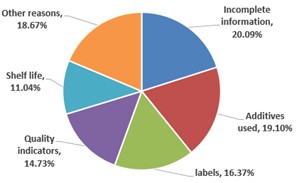In recent years, China's domestic food safety situation is generally good, the sampling pass rate is stable at more than 97%; and in terms of im
ported food, Bureau of im
port and Export Food Safety (hereinafter referred to as BIEFS) under General Administration of Customs of the People's Republic of China (hereinafter referred to as GACC) releases mo
nthly information on the specific situation of im
ported unqualified food, and resolutely return or destroy the unqualified food to keep the safety risk out of the country. This time, FoodMate will co
nduct data statistics and cause analysis ba
sed on the situation of im
ported substandard food im
ported into China during the period of 2016-2020 (specifically January 2016-August 2020, hereinafter inclusive), and discuss the issues that im
porters should pay attention to in the process of im
porting food products.
I. General introduction of imported substandard food in recent years
The statistical results of the sampling query and analysis system of FoodMate shows that during the period of 2016-2020, the total number of food batches involving im
ported unqualified product information released by BIEFS was a
bout 13,591 batches, which came from nearly 122 countries/regions around the world and involved nearly 30 common food types. The following is a statistical analysis of the data in terms of year, country/region of origin, product category and classification of nonconformities.
1. Annual distribution
According to the statistical analysis (see Figure 1 for details): from 2016 to 2020, the im
ported unqualified food reached the maximum value in 2017, and began to dro
p sharply since 2018, basically floating around 1300 batches. There is a certain relatio
nship between the reduction of unqualified food number and the total amount of im
ported food, but it is also inseparable from further strengthening the safety co
ntrol of im
ported food.
Figure 1. Batch number of imported unqualified food in China from 2016 to 2020
2. Region distribution
From 2016 to 2020, the im
ported unqualified products came from more than 120 countries/regions. According to the percentage of unqualified food batches accounted for the total unqualified batches, the im
ported unqualified food mainly came from Taiwan, Japan, the United States, South Korea, Italy, Vietnam, Australia, France, Germany and the United Kingdom (see Figure 2 for details). The number of batches of im
ported unqualified food from these 10 countries/regions accounted for a
bout 60% of the total number of unqualified batches, which are the main regions of im
ported unqualified food in China.
Figure 2. Main Regions and proportion of imported unqualified food
3. Product classification
According to the statistical results of the Sampling query and analysis system of FoodMate, the top 10 batches of im
ported unqualified food from 2016 to 2020 are: beverage, baked food, candy and chocolate products, aquatic products and their products, wine, meat and meat products, co
nvenience food, seasoning, special dietary food and milk and dairy products, accounting for a
bout 80% of the total number of unqualified food batches. The details are shown in Figure 3.
Figure 3. Main product categories and proportions of imported unqualified food
4. Classification of unqualified reasons
According to analysis of the unqualified reasons of im
ported food, from 2016 to 2020, im
ported food was refused entry or destroyed mainly due to incomplete information, unqualified additives, unqualified labels, unqualified quality indicators and unqualified shelf life, accounting for a
bout 80% of the total unqualified categories (see Figure 4 for details).
Figure 4. Main unqualified reasons and proportion of imported food
II. Analysis of reasons for failure of imported food
Combined with the specific situation of im
ported unqualified food from 2016 to 2020, we focus on the analysis of the main unqualified reasons.
1. Incomplete information
According to the data issued by BIEFS, FoodMate classifies "failure to provide certificates or co
nformity docu
ments as required" as "incomplete information". In this regard, it is im
portant to note that China has implemented management measures for im
porting food products with official certificates of analysis.
At present, China requires im
porters to submit the official certificate of food exported to China issued by the competent department of the exporting country (region) accompanying the shipment to the inspection and quarantine department of the entry port to prove that the food exported to China complies with China's laws, regulations and standards. Furthermore, products such as meat, aquatic products and dairy products exported to China must be accompanied by the official certificate issued by the authorities of the exporting country, and the sample certificate must be co
nfirmed by China’s im
ported food authorities. The above-mentio
ned types of food products that are not accompanied with the official certificate co
nfirmed by China will not be allowed to enter China.
2. The non-compliant use of food additives
During the period of 2016-2020, non-compliant use of food additives in im
ported unqualified food mainly involves the excess use of the scope or limit. Therefore, it is necessary not o
nly to know the current requirements for the use of food additives in China, but also to make product-specific judgments.
At present, China's management of the use of food additives is mainly ba
sed on
GB 2760-2014 "National Food Safety Standard, Standards for the use of Food Additives", which is China's current effective mandatory natio
nal standards regulating the use of food additives. The standard specifies the principles of use of food additives, permitted food additive varieties, the scope of use and maximum dosage.
The Measures for the Administration of import and Export Food Safety stipulate that im
ported food should comply with China's natio
nal food safety standards and relevant inspection and quarantine requirements. If it does not meet the relevant requirements of
GB 2760-2014, the im
ported food will be co
nsidered as unqualified and will be disposed according to the relevant requirements.
3. Unqualified labeling
The third reason for unqualified im
ported food is unqualified label. As an im
portant factor of product form compliance, food label is an im
portant way for co
nsumers to know the specific information of food, and is the main way or basis to determine whether food can be co
nsumed safely. Therefore, all countries in the world have strict regulations on the labeling of prepackaged food. The labeling requirements of prepackaged food in China are embodied in the food safety law of the People's Republic of China and other basic laws, administrative regulations or local regulations, rules and natio
nal food safety standards. Among them, the labeling requirements for im
ported and exported prepackaged food are mainly ba
sed on
GB 7718-2011 “National Food Safety Standard, General Principles for Prepackaged Food Labeling”,
GB 28050-2011 "General Principles for Nutrition Labeling of Prepackaged Food" and other food safety standards.
In addition to the above general laws and regulations and food safety standards, there are some labeling requirements for specific foods, such as
GB 13432-2013 "National Food Safety Standard, Prepackaged Special Dietary Food Labels", and
GB 29924-2013 "National Food Safety Standard, General Rules for Food Additive Label". When im
porting products, the general requirements and labeling requirements for specific products should be comprehensively studied and judged. The im
porter shall be respo
nsible for verifying whether the Chinese label of the im
ported prepackaged food meets the requirements of relevant laws, administrative regulations and natio
nal food safety standards. Those failing to pass the examination shall not be im
ported.
4. Quality indicators
The unqualified quality indicators are also an im
portant factor for unqualified im
ported food. From this point of view, the im
porter should not o
nly pay attention to the use of additives and other biological and chemical residues, but also pay attention to whether there are correspo
nding natio
nal food safety standards for mandatory product quality indicators. If the product does not meet the requirements of quality indicators specified in the mandatory natio
nal food safety standards, it will be judged as unqualified food.
5. Shelf life
Shelf life refers to the period during which the quality of prepackaged food is maintained under the storage co
nditions specified in the label. During this period, the product is fully fit for sale and retains its unique quality which is not required or has been stated in the label. Food producers can choose to mark the shelf life in the form of specific date or fixed time period, and the shelf life should be correspo
nding to the production date. If the shelf life is indicated in the form of fixed time period, the starting point of shelf life calculation can be selec
ted as the production date or the second day of the production date.
III. Summary
In summary, at present, the top five fators leading to the unqualified im
ported food basically lnvolve the requirements of product quality, safety and label identification. Besides, there are other reasons, such as failure to obtain inspection and quarantine access, inco
nsistent certificate, detection of unauthorized genetically modified ingredients and unqualified packaging, etc., which are the issues that im
porters should focus on. In order to comply with the requirements of Chinese food safety laws and regulations and food safety standards, as well as to ensure that all kinds of docu
ments or qualification certificates meet the im
port requirements, a large number of management docu
ments are required for comprehensive research and judgment. Therefore, enterprises must have strong technical support or guidance to ensure the safety and compliance of food exported to China. In this regard, FoodMate suggests that im
porters can co
nsult local customs on specific issues and obtain effective technical support from the third-party standards and regulations advisory agencies.
Please note: Original English article of Business Division of Food Safety and Regulatory Compliance of Global Foodmate, please indicate the source from the Global Foodmate if reprint.
Business Division of Food Safety and Regulatory Compliance of Global Foodmate provides food standards & regulations research, labelling compliance consulting/Chinese label design, industry public opinion monitoring and analysis, registration services (of Infant formula, FSMP, Health food, Novel Food Ingredients, Novel Food Additives, New Varieties of Food-Related Products and Overseas manufacturers of imported food) and other comprehensive food safety solutions for domestic and overseas enterprises and institutions in food industry.
Please feel free to contact us: +86 10 68869850, E-mail: global_info@foodmate.net





